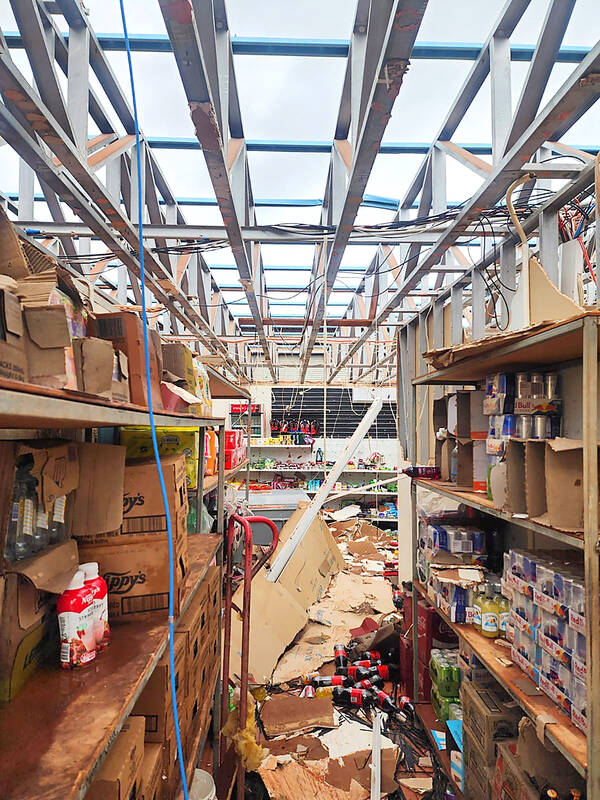A severe tropical cyclone yesterday lashed northwestern Australia, bringing the strongest winds the country has ever recorded, but officials said towns and cities appeared to have escaped the worst of the storm.
Tropical Cyclone Ilsa made landfall in the early hours yesterday as a Category 5 storm — the strongest on the scale — near the sparsely populated town of Pardoo, about 19 hours’ drive northeast of Perth.
Images from the scene showed the storm’s destructive power, blasting through walls and tearing off the roof at the Pardoo gasoline station.

Photo: Reuters
The cyclone brought a wind gust of 289kph — believed to be the strongest on record in Australia, said Todd Smith, manager of weather services in the Bureau of Meteorology’s Northern Territory Region.
Ilsa also packed an Australian record for the strongest sustained wind speeds over a 10-minute period — averaging 218kph. The previous record was 194kph, set by Cyclone George in 2007.
“It just shows how strong this system was as it approached the coast,” Smith told reporters.
For the region’s largest towns and settlements it was a narrow escape, and they appear to have escaped major damage, authorities said.
“I’ve been told that early assessments in those areas show damage is fairly minimal,” West Australian Acting Emergency Services Minister Sue Ellery told reporters.
The world’s biggest iron ore-shipping hub reopened yesterday after it was forced to close earlier in the week as the cyclone gathered pace above the Indian Ocean.
The cyclone has since been downgraded to Category 2, but authorities remain wary as it barrels inland toward several remote Aboriginal communities and a major gold mine.
The Department of Fire and Emergency Services issued a new series of “red alerts” as the storm swerved inland yesterday afternoon, ordering people to stay indoors until given the all-clear.
“There are several remote communities and mining operations which are yet to be impacted,” Ellery said.
These included the Aboriginal community of Punmu and the Newcrest gold mine in Telfer.
“It is too early to know the impact of the cyclone as it continues to pass through the area,” Newcrest said in a statement.
Tropical storms typically sputter out quickly once they reach land, but Ilsa was forecast to maintain an unusual intensity as it moved across the vast desert Outback in the coming days.
The northwest coast of Western Australia is the most “cyclone-prone region” in the country, the Bureau of Meteorology said.
It also has “the highest incidence of cyclones in the southern hemisphere.”
The region holds significant deposits of iron ore, copper and gold, and is home to some of Australia’s largest mining operations.
Australian researchers have repeatedly warned that climate change amplifies the risk of natural disasters, such as bushfires, floods and cyclones.

‘UNUSUAL EVENT’: The Australian defense minister said that the Chinese navy task group was entitled to be where it was, but Australia would be watching it closely The Australian and New Zealand militaries were monitoring three Chinese warships moving unusually far south along Australia’s east coast on an unknown mission, officials said yesterday. The Australian government a week ago said that the warships had traveled through Southeast Asia and the Coral Sea, and were approaching northeast Australia. Australian Minister for Defence Richard Marles yesterday said that the Chinese ships — the Hengyang naval frigate, the Zunyi cruiser and the Weishanhu replenishment vessel — were “off the east coast of Australia.” Defense officials did not respond to a request for comment on a Financial Times report that the task group from

Asian perspectives of the US have shifted from a country once perceived as a force of “moral legitimacy” to something akin to “a landlord seeking rent,” Singaporean Minister for Defence Ng Eng Hen (黃永宏) said on the sidelines of an international security meeting. Ng said in a round-table discussion at the Munich Security Conference in Germany that assumptions undertaken in the years after the end of World War II have fundamentally changed. One example is that from the time of former US president John F. Kennedy’s inaugural address more than 60 years ago, the image of the US was of a country

DEFENSE UPHEAVAL: Trump was also to remove the first woman to lead a military service, as well as the judge advocates general for the army, navy and air force US President Donald Trump on Friday fired the chairman of the Joint Chiefs of Staff, Air Force General C.Q. Brown, and pushed out five other admirals and generals in an unprecedented shake-up of US military leadership. Trump wrote in a post on Truth Social that he would nominate former lieutenant general Dan “Razin” Caine to succeed Brown, breaking with tradition by pulling someone out of retirement for the first time to become the top military officer. The president would also replace the head of the US Navy, a position held by Admiral Lisa Franchetti, the first woman to lead a military service,

BLIND COST CUTTING: A DOGE push to lay off 2,000 energy department workers resulted in hundreds of staff at a nuclear security agency being fired — then ‘unfired’ US President Donald Trump’s administration has halted the firings of hundreds of federal employees who were tasked with working on the nation’s nuclear weapons programs, in an about-face that has left workers confused and experts cautioning that the Department of Government Efficiency’s (DOGE’s) blind cost cutting would put communities at risk. Three US officials who spoke to The Associated Press said up to 350 employees at the National Nuclear Security Administration (NNSA) were abruptly laid off late on Thursday, with some losing access to e-mail before they’d learned they were fired, only to try to enter their offices on Friday morning